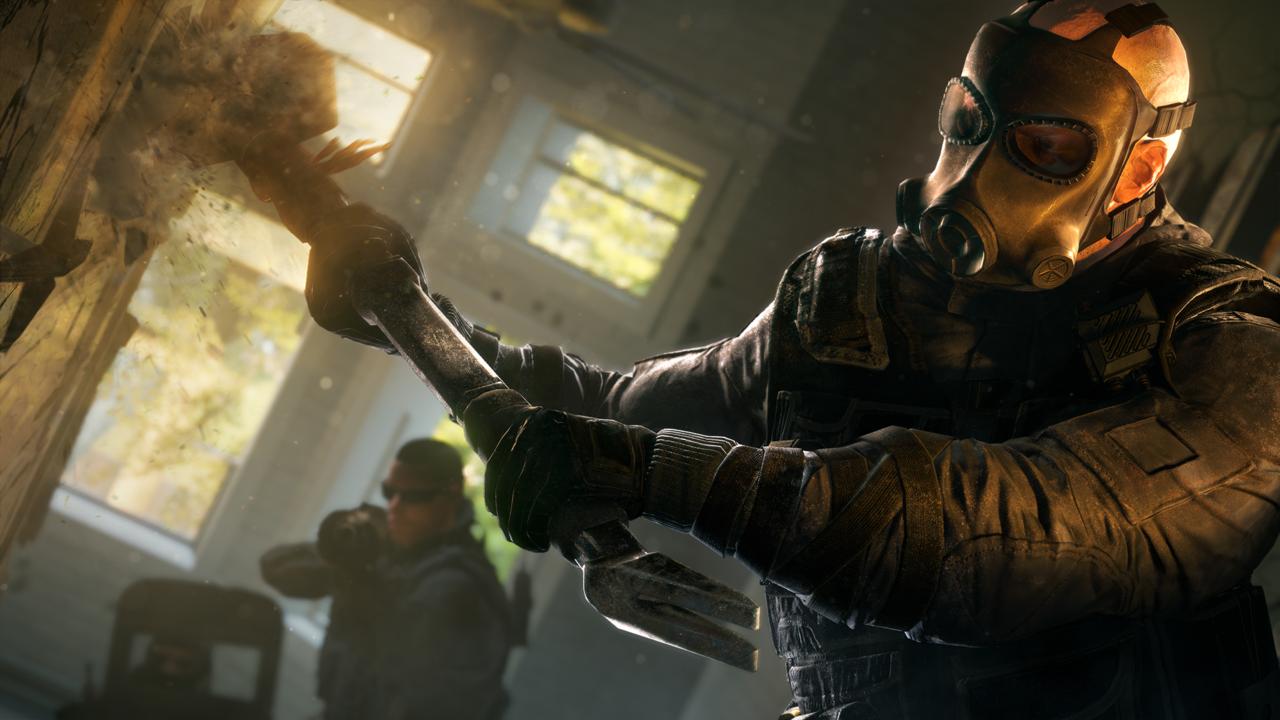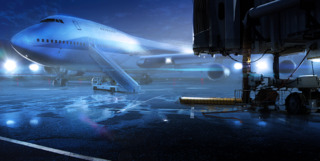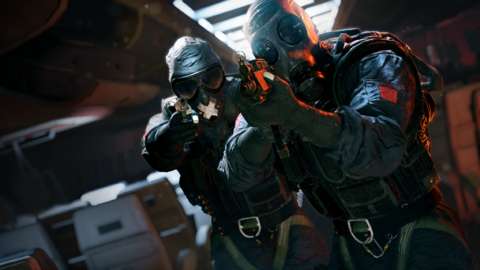As I comb through raw gameplay footage of Rainbow Six Siege, I keep remembering the thought I had almost every time I finished a match: I could do better. I should've known they'd breach that wall, should've fortified that trap door, should've jammed their electronics, should've rappelled up to that window, should've leaned around that corner, and on and on and on. Even when I won, there was always something I could have done better. But rarely was that thing as simple as "aim faster and shoot more accurately."
At a recent press event, I got to play a closed alpha version of Rainbow Six Siege, the same version that will be made available for a limited group of players sometime in the coming weeks. Siege is a first-person shooter in which a team of five players holds a hostage in a small structure and a team of five other players tries to extract the hostage. The teams are also trying to kill each other, naturally, but actual gunplay is usually the last thing that happens in a match, and firefights are usually over very quickly. The core of the game, then, and the part that makes Siege so compelling, is what happens before the bullets start flying.
Metaphor: ReFantazio The King’s Trial Trailer Tales of the Shire - Official Announcement Trailer Dead Island 2 – Steam Launch Trailer Nickelodeon All-Star Brawl 2 - Official Zuko Gameplay Spotlight Trailer Valheim: Ashlands - Official Gameplay Trailer Tales of Kenzera: ZAU GameSpot Video Review 2XKO - Official Illaoi Champion Gameplay Reveal Trailer Stellar Blade - Beta Skills Gameplay Trailer | PS5 Games Stellar Blade - Burst Skills Gameplay Trailer | PS5 Games GODDESS OF VICTORY: NIKKE | New Main Chapter 29~30 Update Trailer GODDESS OF VICTORY: NIKKE | Happy 1.5 Anniversary Trailer GODDESS OF VICTORY: NIKKE | Kilo Character Motion Demonstration Trailer
Please enter your date of birth to view this video
By clicking 'enter', you agree to GameSpot's
Terms of Use and Privacy Policy
Let's say you're holed up in the cargo area of a plane with your hostage. You have 45 seconds to set up fortifications to help you survive and keep custody of the hostage during a three minute assault. Where do you start? This is an Air Force One-size jet, so there's a lot of interior space to cover. Barricading doors to slow enemy progress is a good first step, but you also want your allies to be free to set up their own defenses, and closing off doorways limits their mobility. The walls in the room are thin, so it'll be no problem for invaders to shoot or breach their way through. Better get some reinforcing panels up, unless your plan is to shoot out through the walls when the enemy shows up. There are too many points of entry to reinforce them all, so set some deployable cover and gas traps to cover their most likely point of entry, provided your team can agree on where that is. Oh, and by the way, your foes have been scouting your defenses this entire time with remote-controlled drones. Maybe you should've set up that electronic signal jammer before you did any of this?
At any given moment, there are multiple things you could be doing to improve your situation, and that's just the preparation stage. Once the three-minute timer begins and the infiltrators start coming, you have to stand firm behind your defenses or scramble to cover some new contingency that is developing before your eyes. Likewise, the attackers can formulate a plan based on the intel they gather from their drone phase, but who knows where the defenders will actually be waiting?

Siege is as much a battle of knowledge as it is a battle of reflexes. Crouching in a corner to check the security camera feed on your tablet can be as valuable as laying down suppressing fire, and both are crucial to victory. Taking time for recon can leave you vulnerable to attack, but the knowledge you gain can give you a significant edge. Deciding when to focus on what is one of the central challenges of Siege matches.

There have been two maps revealed thus far: the house from the E3 demo and the aforementioned airplane (which, by the way, is parked on the tarmac, not mid-flight). Each has three main levels surrounded by exterior and rooftop areas that allow you to reach different entry points. Knowing the map gives you an edge in any competitive shooter, but because of Siege's extensive environmental destructibility, it's absolutely paramount. It's not enough to know where a wall (or a ceiling or a floor) is and what's on the other side. You have to know if it can be shot through, and what the firing lines from the other side might be. If the ceiling starts exploding, you need to know if enemies will be dropping into the room with you or simply shooting through the floorboards. And even when you know the surfaces well, the layout of the map evolves differently in every match as gunfire and explosions obliterate cover and open up new sightlines.
The other big variable from match to match is the individual operators. The final version of Rainbow Six Siege will have 20 unique characters to choose from; the closed alpha version I played only had 10. While the standard choices of primary weapon, secondary weapon, and gadget are available to all, each operator has a specific skill that only they can perform. The attacking characters I saw could breach reinforced walls, smash normal walls with a sledgehammer, disrupt electronics with a grenade, fire a breach charge to destroy walls from a distance, and scout with a small drone armed with a shock weapon. On the defending side, I used an electronic jammer to block the remote activation of breach charges and drones, placed toxic gas traps, used reinforced barricades, laid down extra armor vests for the team, and used a heartbeat sensor to detect enemies through walls and floors.

Each of the abilities can tip the scales when applied properly, and each can be countered, if you're prepared. You won't know which of the 10 attackers your five foes have chosen until you or a teammate spots them. The character designs appear to be generic, armored police at first glance, but a closer look reveals quickly recognizable attributes that will allow experienced players to identify their foes on sight (helmets, gas masks, hair, glasses, etcetera). Icons at the top of the screen also signal which operators are in play, once you've scouted them, so you can be on the lookout for, say, a quick hammer breach when you know Sledge has taken the field. With ten choices per side, there are going to be abilities that get left out of each match, making adapting your plan to account your enemies' strengths even more important.
The fast, heated gun battles of Siege are often over as soon as they start because one player has scouted the situation better and is more prepared. Fights are won and lost by intel, and during my first few hours playing the game, I felt like I was slowly filling up a mental almanac of possible tactics and countertactics. With each round, my knowledge base improved as I regularly encountered new situations or new enemy maneuvers. Between each match, my teammates and I quickly shared our stories, identifying where we had gone wrong and scheming about what we could do next round. It was exciting to discover and test out new strategies, and regardless of whether I won or lost, I entered each new match feeling more poised and prepared than before. Rainbow Six Siege is shaping up to be a shooter in which knowledge is as powerful as a quick trigger finger, and perhaps even more rewarding.

